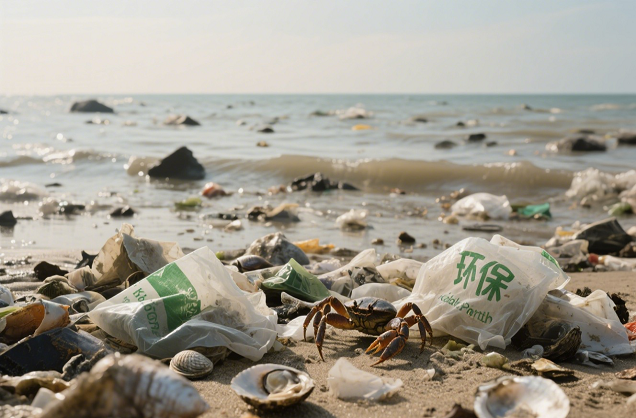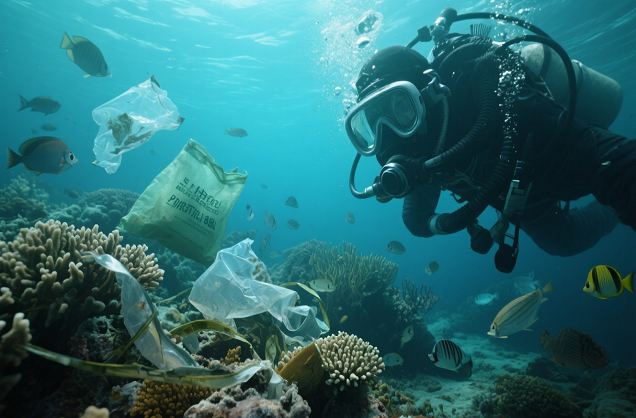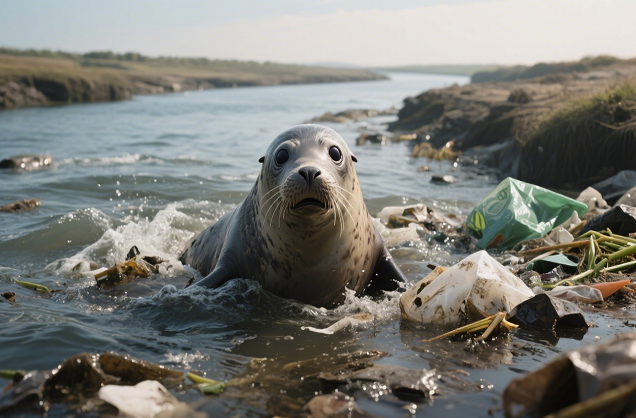The “eco-friendly” plastic bags you buy could be poisoning the oceans.
The Ocean Crisis Under the Eco-Label
Plastic bags labeled as "biodegradable" or "eco-friendly" have become increasingly common in recent years, and many consumers are willing to pay a higher price for them in the belief that they are doing their part to help the environment. However, according to a recent report by the United Nations Environment Program (UNEP) in 2024, more than 65% of the world's "eco-friendly" plastic bags do not actually degrade in the oceans, and produce even more microplastic pollution than traditional plastics.

Part I: 3 types of "pseudo-environmental" plastic bags that are poisoning the oceans
1. Oxo-degradable
? Problem:
made from traditional PE plastic + degradation additives
breaks up into micro-plastics only and cannot be broken down by micro-organisms
banned by the EU, Canada and more than 40 other countries
? Experimental data:
Time Status Micro-plastic release 0 months Change Microplastic release
0 months Complete bag 0 mg
6 months Cracks on surface 120 mg/m²
12 months Fragmentation into <5mm pieces 580 mg/m²
2. Industrial compostable PLA
? Problems:
Requires 58-60°C industrial composting environment to decompose
Almost non-degradable in room temperature seawater
Causes intestinal blockage when accidentally ingested by marine organisms
? Real-life examples:
Large amounts of "compostable" PLA tableware residues were found on the coast of Hawaii in 2023, testing showed:
After 18 months of seawater immersion, the weight had decreased by only 3%. After 18 months of seawater soaking, only 3% weight loss
PLA microplastics detected in the stomachs of young albatrosses
3. Starch-mixed plastics
? Problems:
Usually contains 30-70% of conventional plastics (PP/PE)
Plastic skeleton remains after starch has partially degraded
More prone to form "porous microplastics" that can attract toxic substances
? Microscopic observation:
Honeycomb plastic structure left after starch has degraded Structure
Adsorbs 2 times more pesticides and heavy metals than ordinary microplastics.

Part 2: Laboratory tests - which materials are truly ocean-friendly?
Experimental methodology:
Five material samples were placed in artificial seawater at 25°C and tested periodically:
Weight loss rate
Microplastic release
Degree of microbial decomposition
12-month results:
Material type Weight loss Microplastic production Ecotoxicity
Conventional PE plastics 0% Very high Severe
Oxo-degradable plastics 5% Very high Severe
Industrial PLA 3% Medium Medium Medium
Starch-blended plastics 15% High High
PHA 92% 0 None

Part III: 4 Steps to Identify Real and Fake Eco Bags
1. Look at the certification mark
✅ Real Marine Degradable:
TÜV Marine Degradable Certification (Marine Degradable)
OK Biodegradable MARINE
❌ False Mark:
"Degradable" (no specific standard)
"Oxo-biodegradable" (banned in EU)
2. Check the ingredient list
Safe ingredients: PHA, PHBV
Dangerous ingredients: PE, PP, "Oxo-biodegradable"
3. Do a simple test
① Cut a small strip and put it in warm water (25-30°C)
② Add a spoonful of active composting bacteria (simulating marine microorganisms)
③ True PHA: softens and crumbles in 2 weeks
④ False degradation: no change in 1 month
4. Choose a trustworthy brand
Brands that meet the standards of the real test in 2024:
Danimer Scientific (PHA fishing nets)
RWDC Industries (PHA straws)
TIPA (marine degradable packaging film)

Part IV: What can we do for the ocean?
Consumer Action:
Refuse to buy "eco-bags" without specific certification
Use canvas bags or real PHA products
Collect pseudo-biodegradable plastics separately when participating in beach cleanups
Corporate Responsibility:
Stop using oxo-biodegradable plastics
Clearly label products with degradation conditions and times
Invest in real ocean-friendly materials such as PHA
Policy Recommendations:
Harmonize ocean degradation certification standards globally
Impose a 10% penalty on sales for false environmental claims Policy Recommendation: Harmonize marine degradation certification standards globally
 Significant progress in PBAT/s
Significant progress in PBAT/s
 PLA/PBAT composite film degrad
PLA/PBAT composite film degrad
 A New Choice for Takeaway Pack
A New Choice for Takeaway Pack
 Significant progress in PBAT+s
Significant progress in PBAT+s
CONTACT
Add: Room 4006, No.1 Helong Yiheng Road, Baiyun District, Guangzhou City
Tel: +8613450255948
Wechat : +86-13450255948
Fax: +86-13450255948
E-mail: 13450255948@163.com








